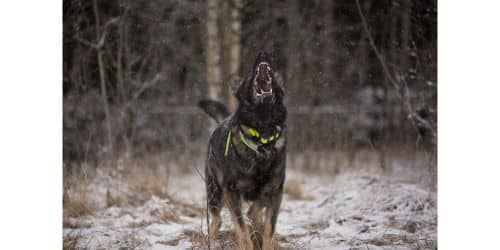Your dog’s grass allergies are caused by his immune system overreacting to grass pollens in the air. This allergy is an inhalant allergy, also known as atopy, and is the second most common type of dog allergy. Your dog’s overactive immune system is attempting to rid itself of something that it incorrectly perceives to be dangerous. We’ll discuss the major causes of grass allergy in dogs in this article, as well as its treatment.
What Is A Dog Grass Allergy?
Grass allergies, which are common in dogs, are inhalant allergies caused by pollen associated with grasses. Because grass pollens are airborne, your dog does not need to be on the grass to experience symptoms. Grass allergies can result in skin or upper respiratory allergies.
Grass allergies are generally worse in the spring and fall seasons, when grass pollen is more prevalent due to seasonal species variation, but they can affect your dog all year. The allergens (grass pollens) are absorbed by the skin and mucus membranes in dogs. Many dogs who are allergic to grass may also be allergic to fleas and food.
Grass allergies can occur at any age, but most dogs develop allergies after the age of one due to prior allergen exposure. While the symptoms may be bothersome for your dog, the majority are not life-threatening.
Anaphylaxis, or a severe allergic reaction, is uncommon. Anaphylaxis can happen within 5-30 minutes of coming into contact with the allergen. Because of the different shock organs involved, symptoms in dogs may differ from those in humans. Severe hives, facial swelling (especially around the eyes and muzzle), wheezing, difficulty breathing, and an increased respiratory rate are all possible in dogs. Vomiting and diarrhea, with or without blood, are also possible.
Grass Allergy Symptoms in Dogs
Grass allergy can cause the following symptoms in dogs:
- Skin sensitivity (erythema)
- Itching all the time
- Scratching
- Licking
- Pruritus is the chewing of the face, feet, armpits, and sides of the body.
A rash may appear as well, but because of the haircoat on dogs, redness and a visible rash may be difficult to see.
What Causes Grass Allergy In Dogs?
Grass allergies, caused by common grass pollens from grasses such as Bermuda, fescue, alfalfa, or rye, have symptoms similar to tree (cedar, pine, oak) and weed pollen allergies (ragweed, pigweed).
Direct contact can cause symptoms in dogs who enjoy rolling in the grass. Others may develop symptoms after inhaling pollen while walking or simply being in an area with grass pollen, even if they are indoors.
This happens a lot in the spring and fall, when grass is growing and pollen leaves a yellow trail of dust behind. If a dog walks through a pollen-infested area and pollen comes into contact with mucous membranes (nose, eyes, mouth), skin, or feet, the dog may exhibit symptoms.
Diagnosing Grass Allergy In Dogs
Your veterinarian will take a detailed history of your dog’s symptoms, including symptom duration, severity, seasonality, and treatment (if any).
A thorough examination of the haircoat and skin would be the next step. The distribution of hair loss, any skin lesions such as pimples, rashes, dry or oily skin, and scratches (excoriations) caused by itching, redness, or skin irritation (to indicate inflammation) will aid in the diagnosis.
Depending on the circumstances, treatment can be initiated based solely on clinical symptoms, with no additional testing required. If topical or conservative treatments do not work, more testing may be required.
Serum blood testing for allergies can be performed by your primary veterinarian. The gold standard of allergy testing, however, and the one test that provides the most accurate results, is an Intradermal Skin Test performed by a veterinary dermatologist. Typically, the intradermal test is performed under light sedation. The abdomen of the dog is shaved, and specific allergens are injected.
The area is checked for the presence of hives, which indicate an allergic reaction to the allergen injected there. If the allergens are identified, treatment is tailored to the individual pet.
Another option is hyposensitization therapy, which involves “micro-dosing” the allergen on the pet over time to build up resistance.
Grass Allergy Treatment in Dogs
There are many treatments and medications available to help with allergies in dogs, and which medications may be recommended will depend on your dog’s specific symptoms. In addition, a special shampoo to relieve itching and an antibiotic to prevent infection may be prescribed.
Immunotherapy Infusions
These injections work similarly to allergy shots in humans, and they are effective but can take some time to take effect. The veterinarian will show you how to give your dog an injection with a small amount of allergen (grass) every day, gradually increasing the amount each day to desensitize your dog to grass. The disadvantage of this method is that it can take several months of injections before your dog is completely desensitized. It may not completely resolve the symptoms in some cases. Furthermore, these injections can rarely cause a severe reaction known as anaphylaxis, which is a life-threatening emergency. In the event that this complication occurs, your veterinarian can provide you with an epinephrine pen (epi-pen) to inject epinephrine into your dog.
Skin Treatment
Because your dog’s skin is the best way to determine allergies, it is critical to return the skin to normal as soon as possible. Within a few days, a medicated shampoo will help relieve the itching.
Natural Treatment For Grass Allergy In Dogs
Here are some natural dog care remedies that are useful to have on hand during pollen allergy season:
- Coconut oil: its antibacterial properties alleviate itchy skin. When combined with fish oil, it can help your dog’s allergic reactions to pollen.
- Aloe vera: should be used in gel form. It is ideal for treating hot spots and itches due to its anti-inflammatory properties.
- Apple cider vinegar: excellent for cleaning pollen from your dog’s paws.
- Thyme infusion: soothes skin infections and is suitable for toes and paws.
- Anti-inflammatory supplements such as fish oil and turmeric may be beneficial to your pet.
- Before attempting any of these or other natural treatments, consult with your veterinarian.
Other Types of Dog Allergies
There are many different kinds of allergies in dogs. Skin allergies, food allergies, and environmental allergens all pose difficulties for dogs and their owners, and to make matters more complicated, the symptoms of all of these allergies can overlap.
Skin Allergies
The most common type of allergic reaction in dogs is skin allergies, also known as allergic dermatitis. Skin allergies in dogs are caused by three main factors:
- Dermatitis due to flea allergy
- Allergies to foods
- Allergens in the environment
An allergic reaction to fleabites causes flea allergy dermatitis. Flea saliva causes allergies in some dogs. This causes extreme itching in affected dogs, particularly at the base of the tail, and their skin to become red, inflamed, and scabbed. You may also notice flea signs such as flea dirt or even see fleas themselves.
Itchy skin can also be caused by food allergies and sensitivities. Dogs with food allergies frequently scratch their ears and paws, which may be accompanied by gastrointestinal symptoms.
Atopic allergic reactions or atopic dermatitis can be caused by environmental allergens such as dust, pollen, and mold. Most allergies are seasonal, so you may notice your dog itching only at certain times of the year. The most commonly affected areas, as with food allergies, are the paws and ears (but also include the wrists, ankles, muzzle, underarms, groin, around the eyes, and in between the toes).
Secondary infection is a risk with all skin allergies. When your dog scratches, bites, or licks his skin, he exposes himself to yeast and bacterial infections that may require treatment.
Food Allergies
According to AKC Chief Veterinary Officer Dr. Jerry Klein, true food allergies may be less common than people believe. True food allergies cause an immune response, which can manifest as skin conditions (hives, facial swelling, itchiness), gastrointestinal symptoms (vomiting and/or diarrhea), or a combination of the two. A severe reaction resulting in anaphylaxis can occur in rare cases, similar to severe peanut allergies in humans.
But what about all the dogs who require hypoallergenic dog food diets?
Most people mean that their dog has a food sensitivity, also known as a food intolerance when they say that their dog has a food allergy. Food sensitivities, unlike true allergies, are the result of a gradual reaction to an offending ingredient in your dog’s food, such as beef, chicken, eggs, corn, wheat, soy, or milk.
Food sensitivities in dogs can cause gastrointestinal symptoms such as vomiting and diarrhea, as well as dermatologic symptoms such as itchiness, poor skin and coat, and chronic ear or foot infections.
Working with your veterinarian to manage your dog’s symptoms and identify the ingredient causing the reaction is the best way to diagnose and treat a food allergy.
Acute Allergic Reactions
An acute allergic reaction is one of the most concerning types of allergies in dogs. Dogs, like humans, can experience anaphylactic shock if they have a severe allergic reaction to an allergen. If not treated, this can be fatal.
Bee stings and vaccine reactions, among other things, can cause anaphylactic reactions in some dogs, which is why you should always keep a close eye on your dog after administering any new vaccine, drug, or food item. Fortunately, anaphylactic reactions in dogs are uncommon.
In response to an allergen, your dog may develop hives or facial swelling. Swelling of the face, throat, lips, eyelids, or earflaps may appear serious, but it is rarely fatal, and it can be treated with an antihistamine by your veterinarian.
In Conclusion,
Anything can cause a dog to become allergic, but grass is one of the most common. A dog’s allergy to grass is similar to a human’s allergy to tree pollen. The pollen from grass can cause an allergic reaction in dogs at some point in their lives. Dogs with grass allergies do not have to be kept away from grass during pollen season. Keeping your grass mowed and limiting its movement, on the other hand, may help reduce the amount of pollen in the air.
Related Articles
- BREWER’S YEAST FOR DOGS: What Are The Benefits?
- WHAT YOU SHOULD KNOW ABOUT FLEA DIPS FOR DOGS
- Best OTC and Natural Appetite Stimulant For Dogs
- Can Dogs Take Claritin For Allergies?






